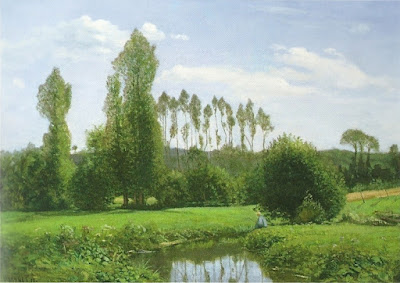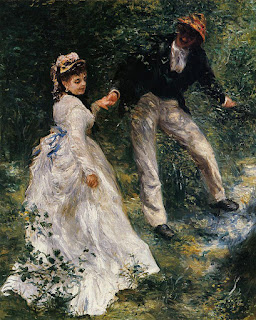23. (French) Impressionism – Modernism Takes Hold (1870-1926)
Some notes taken from Waldemar Januszczak’s documentary series The Impressionists: Painting & Revolution.
What was it about? What were the goals?
Impressionism was an art movement based on several ideas:
⦁ It was an act of artistic rebellion, in which artists who had been rejected by the Paris Salon formed their own club, and held their own independent art exhibitions––what art historian Waldemar Januszczak called “eight art shows that changed the world.”
⦁ Impressionist painting was cheerful and optimistic, celebrating the new modern world: the transformation of Paris, new technology such as railroads, and the rising, liberated middle class. It studied modernity in detail, inspired by realists like Courbet and Manet.
⦁ Stylistically, Impressionists cared very much for the nature of light and color and how it was affected by time of day, weather, reflections, and atmospheric conditions. They believed in painting outdoors, ignoring little details and eschewing precise drawing. Instead, they cared about working quickly, capturing the essence of a subject, getting the colors and shapes right with big bold, expressive brushstrokes.
⦁ They painted on a white background––we take it for granted today, but before the Impressionists, artists preferred working on dark-ground under paintings.
⦁ They also avoided black paint, instead mixing complimentary colors for darks and greys.
⦁ Since they tried to finish most works in one sitting, there was no use of transparent glazing, so the works are all opaque.
⦁ Impressionism also worked with optical mixing, placing colors side-by-side without blending, an idea that would be explored further with Pointillism.
⦁ Impressionism began to end as the optimism of modern life gave way to anger over growing poverty, lack of worker’s rights, and class struggle. It gave way to the pessimism of expressionist art
A bit of historical context, and what made it modern?
To understand how Impressionists were revolutionary, you have to understand the salon system and how it worked. A salon was a juried exhibition, and the jurors were the professors of the Academie des Beaux-Arts. They only accepted artwork that fit their taste and sensibilities. Likewise, they only admitted students they liked into the Academie, and only suggested their best students to paint commissions for the state, and then to join their ranks as new professors. Getting a place in the Academie assured one of success and fame, but meant you had to paint exactly what they wanted. It stifled freedom and creativity. As noted earlier, many artists and movements struggled to gain acceptance under this system. The Impressionists failed too, but then they decided to undermine the whole system by holding their own revolutionary shows, helped by the great art dealer Durand-Ruel.
Impressionism couldn’t have existed without new technology:
1. paint tubes, that allowed artists to leave the studio, painting outdoors.
2. New synthetic colors in these tubes, such as: cobalt blue, ultramarine blue, cerulean blue, viridian, and cadmium yellow.
3. folding easels, that folded up into a light, convenient box, easy for travel.
4. brushes with tin ferrules, for flat brushes and clean, thin lines.
5. brushes made from coarse pig’s hair, for scratching around thick globs of paint.
6. new pastels, made of pigment and chalk, allowed for drawing quickly in color.
7. railways, to transport artists to many different towns and places.
8. photography, showed artists how people and animals look when moving, and influenced compositions. Before them, most artists chose a main subject as the focal point, and everything else was secondary. The Impressionists challenged this, at times placing several focal points, putting into question if a work was about the sitter or the background, creating an effect like a camera snapshot, as if you were really there. The Impressionists’ loose, painterly style was also a reaction to photography, which devalued the notion of precise, realistic rendering. Impressionists instead focused on the aspects of picture making that photography lacked – color and subjectivity.
In addition to new technology, Impressionism was also influenced by the asymmetrical compositions and colors of Japanese printmaking which was very popular in the 19th century.
The underlying philosophy of the period:
There are several core concepts to great Impressionist painting. They shared the Realist belief you should only paint what you see right in front of you. They felt, like the Barbizon School, you should go out and find your subjects around you. They also felt an artist is like a record keeper of history, and should record real life, whatever’s happening now, so that future generations may gain a greater understanding of the times. Since this was of fundamental importance, little details were insignificant clutter. Impressionists believed in creating beauty, but found it in the basic forms and colors of light.
How was it represented in other arts – music, architecture, and literature?
Impressionism was popular in a number of other arts. Impressionist cinema came into fashion from 1919-1929 with Abel Gance, Epstein, Dulac, Delluc, and others. In music, Debussy and Ravel are considered the greatest Impressionist composers. Their music favored shorter works with bigger chords (5 and 6 part harmonies, not just 3), major 7th chords, and whole tone scales.
In literature, Impressionism refers to works that describe, rather than interpret, the little things going around the characters and the thoughts in their heads, much like stream-of-consciousness. Writers include Baudelaire, Rimbaud, Virginia Woolf, D.H. Lawrence, and Joseph Conrad.
What made it great?
Any art teacher will agree that color is the most evocative element in painting. It might not be the most important to the structure of a composition, but we have all kinds of mental associations with different colors, and we react automatically with joy to certain color combinations. The Impressionists knew this and studied these effects in detail. As a result, they became some of the most popular artists who ever lived, their works being some of the most expensive, memorable, and well-loved in history. There’s a reason why so many pens, napkins, calendars, and coffee mugs use Impressionist art as decoration. Impressionists are favorites among crowds of people with no art training, from all over the globe. This also explains why it’s still in demand and there are so many Impressionist artists still working today.
Critics of Impressionism come in two forms. There were the 19th century academics who complained of the lack of finish, precision, skill that made it inferior, to their eyes. Then, there are the Modernist critics of today who look back at this time and see quaint, traditional family scenes, and idealized cityscapes, creating false narratives of nostalgia and even promoting male oppression of women, etc. All of these critics attack Impressionism on an intellectual level; they tell you to ignore your lying eyes, and listen to their theories. Luckily, most people would rather look and enjoy the relaxing, beautiful pictures than listen to some half-baked theories about art.
Some people say the Impressionists were simply lazy and didn't know how to paint, or draw. Is that true?
No, this is false. The Impressionists were academically trained artists who simply rebelled against the Academy system. There are plenty of works that show their prowess, before and during their Impressionist phase (I've added some below). It's true they painted much faster than the academics - an Impressionist painting must be done from life, on site, and would be "finished" at the end of one sitting. This was scandalous at the time. What about layers of glazing? What about weeks of detail work and adjustments? The Impressionists answered, what about it? And moved on to new paintings. It wasn't laziness, it was an answer to the new dilemma of how to differentiate painting from photography. Does this make their work inferior to previous generations of art? In some ways yes, it does, but in some ways no. The Impressionists skipped much of detail work - but did so masterfully, tastefully, so that nothing crucial is lost, while a certain sense of motion, of capturing a moment, is gained.
What ended it?
Some people will tell you that Impressionism ended as other experiments in art became fashionable – the constructive approach of Cezanne, the vivid, expressive colors of Gauguin and Van Gogh, the wild lines of Toulouse Lautrec. It’s true that Impressionism fell out of fashion, and a wave of pessimism at modernity, as art historian Januszczak described it, may have turned audiences against it, for a time. But, impressionism keeps coming back, again and again. It’s the default way to paint and to teach painting all over the world. It’s considered the best practice for training as an artist. So, Impressionism hasn’t really ended – no art movement ever really does - and it will most likely continue in perpetuity.
What’s with the haystacks?
Monet is credited with painting haystacks as a popular subject for impressionist study. It was one of his favorite subjects at Giverny, and he would set up several easels in a row, painting the same haystacks over time as the light changed. The farmers, however didn’t like his work, and would actually remove the haystacks early just to spite him. Monet wasn’t the first to paint haystacks, either. Millet painted them fifteen years earlier, granted they were the backdrop for his gleaners and farmhands. But, Monet helped popularize the subject, with many artists trying their brush at it.
Some leading figures:
Camille Pisarro (1830-1903)
Edouard Manet (1832-1883)
Edgar Degas (1834-1917)
Alfred Sisley (1839-1899)
Auguste Rodin (1840-1917) (sculptor)
Oscar-Claude Monet (1840-1926)
Frederic Bazille (1841-1870)
Berthe Morisot (1841-1895)
Pierre-Auguste Renoir (1841-1919)
Gustave Caillebotte (1848-1894)
Maria Bashkirtsheff (1858-1884)
Elin Danielson-Gambogi (Finnish, 1861-1919)
Leading American Impressionists:
(Some of these artists aren't commonly labelled or associated with Impressionists - but they are)
Winslow Homer (1836-1910)
Mary Cassatt (1844-1926)
William Merritt Chase (1849-1916)
John Singer Sargent (1856-1925)
Childe Hassam (1859-1935)
Frederic Remington (1861-1909)
Other Famous Impressionists:
Giovanni Boldini (Italian, 1842-1931)
Anders Zorn (Swedish, 1860-1920)
Ivana Kobilca (Slovenian, 1861-1926)
Joaquin Sorolla y Bastida (Spanish, 1863-1923)
Nicolai Fechin (Russian-American, 1881-1955)
Some of the most famous artworks of the time:






























.jpg)


Comments
Post a Comment